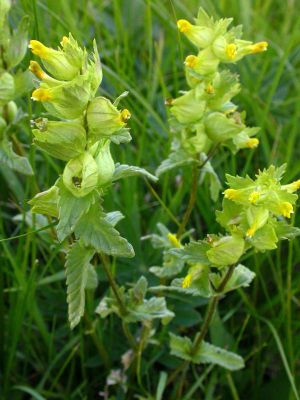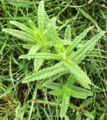Difference between revisions of "Rhinanthus minor"
| Line 4: | Line 4: | ||
* Synonyms/Misapplications: ''Alectoropholus minor, Rhinanthus crista-gallii, R. articus, R. borealis, R. groenlandicus, R. minor'' ssp. ''borealis'' | * Synonyms/Misapplications: ''Alectoropholus minor, Rhinanthus crista-gallii, R. articus, R. borealis, R. groenlandicus, R. minor'' ssp. ''borealis'' | ||
* Codon: RHIMIN | * Codon: RHIMIN | ||
| + | ---- | ||
| + | [[File:RHIMIN8.jpg |thumb|Photo by Ben Legler, 2004, also featured on Main Page]] | ||
| − | ==Taxonomy== | + | ===Taxonomy=== |
{{Taxobox | {{Taxobox | ||
| − | | image = | + | | image = |
| − | | image_alt = | + | | image_alt = |
| image_caption = Photo by Ben Legler, 2004. Featured on Main Page | | image_caption = Photo by Ben Legler, 2004. Featured on Main Page | ||
| name = ''Rhinanthis minor'' | | name = ''Rhinanthis minor'' | ||
| Line 25: | Line 27: | ||
<ref>Integrated Taxonomic Information System. Retrieved from https://www.itis.gov/servlet/SingleRpt/SingleRpt?search_topic=TSN&search_value=504749#null</ref> | <ref>Integrated Taxonomic Information System. Retrieved from https://www.itis.gov/servlet/SingleRpt/SingleRpt?search_topic=TSN&search_value=504749#null</ref> | ||
| − | ==Description== | + | ===Description=== |
Erect hemiparasitic native perennial with opposite, wholly cauline, sessile leaves. | Erect hemiparasitic native perennial with opposite, wholly cauline, sessile leaves. | ||
| Line 40: | Line 42: | ||
Seattle: University of Washington Press.</ref> | Seattle: University of Washington Press.</ref> | ||
| − | ==Bloom Period== | + | ===Bloom Period=== |
June-August | June-August | ||
| − | ==Distribution== | + | ===Distribution=== |
Boreal north America, Greenland, Eurasia, south to Washington and NW Oregon.<ref name=":0" /> | Boreal north America, Greenland, Eurasia, south to Washington and NW Oregon.<ref name=":0" /> | ||
| − | ==Habitat== | + | ===Habitat=== |
Mesic to moist meadows, fields, pastures, roadsides and clearings in lowland, steppe and montane zones, up to about 2,000 feet elevation.<ref>Klinkenberg, Brian. (Editor) 2020. ''E-Flora BC: Electronic Atlas of the Plants of British Columbia'' [eflora.bc.ca]. Lab for Advanced Spatial Analysis, Department of Geography, University of British Columbia, Vancouver. [Accessed: 2020-05-09]</ref> | Mesic to moist meadows, fields, pastures, roadsides and clearings in lowland, steppe and montane zones, up to about 2,000 feet elevation.<ref>Klinkenberg, Brian. (Editor) 2020. ''E-Flora BC: Electronic Atlas of the Plants of British Columbia'' [eflora.bc.ca]. Lab for Advanced Spatial Analysis, Department of Geography, University of British Columbia, Vancouver. [Accessed: 2020-05-09]</ref> | ||
| − | ==Photo Gallery== | + | ===Photo Gallery=== |
<gallery> | <gallery> | ||
File:RHIMIN2.png|seedling, courtesy of CNLM | File:RHIMIN2.png|seedling, courtesy of CNLM | ||
| Line 57: | Line 59: | ||
</gallery> | </gallery> | ||
| − | ==References== | + | ===References=== |
<references /> | <references /> | ||
Revision as of 23:40, 20 March 2021
- Scientific Name: Rhinanthus minor ssp. groenlandicus
- Family: Orobanchaceae
- Common Names: little yellow-rattle, arctic rattlebox
- Synonyms/Misapplications: Alectoropholus minor, Rhinanthus crista-gallii, R. articus, R. borealis, R. groenlandicus, R. minor ssp. borealis
- Codon: RHIMIN
Contents
Taxonomy
| Rhinanthis minor | |
|---|---|
| Scientific classification | |
| Kingdom: | Plantae |
| Subkingdom: | Viridiplantae |
| Phylum: | Tracheophyta |
| Subphylum: | Spermatophytina |
| Class: | Magnoliopsida |
| Subclass: | Asteranae |
| Order: | Lamiales |
| Family: | Orobanchaceae |
| Genus: | Rhinanthus L. |
| Species: | Rhinanthus minor L. |
| Subspecies: | Rhinanthus minor ssp. groenlandicus (Chabert) Neuman |
Description
Erect hemiparasitic native perennial with opposite, wholly cauline, sessile leaves.
Flowers in terminal, leafy-bracteate spikes. Generally glabrous or thinly puberulent on 2 of 4 sides of squarish stem.
Leaves opposite, sessile, and cauline, scabrous and stiff, linear-lanceolate to ovate-lanceolate, toothed, 2-6cm x 4-15mm.
Calyx laterally flattened but somewhat inflated, corolla yellow, bilabiate, galeate, the upper lip hooded and enclosing the anthers.
Fruit is a flattened, orbicular, loculicidal capsule.
Differentiated from Rhinanthis minor ssp. minor by the bluish-gray teeth on the corolla upper lip, R. minor ssp. minor has whitish teeth and is less common.[2]
Bloom Period
June-August
Distribution
Boreal north America, Greenland, Eurasia, south to Washington and NW Oregon.[2]
Habitat
Mesic to moist meadows, fields, pastures, roadsides and clearings in lowland, steppe and montane zones, up to about 2,000 feet elevation.[3]
Photo Gallery
References
- ↑ Integrated Taxonomic Information System. Retrieved from https://www.itis.gov/servlet/SingleRpt/SingleRpt?search_topic=TSN&search_value=504749#null
- ↑ 2.0 2.1 Hitchcock, C. L., Cronquist, A., Giblin, D., & Legler, B. et al. (2018). Flora of the Pacific Northwest: an illustrated manual. Seattle: University of Washington Press.
- ↑ Klinkenberg, Brian. (Editor) 2020. E-Flora BC: Electronic Atlas of the Plants of British Columbia [eflora.bc.ca]. Lab for Advanced Spatial Analysis, Department of Geography, University of British Columbia, Vancouver. [Accessed: 2020-05-09]




